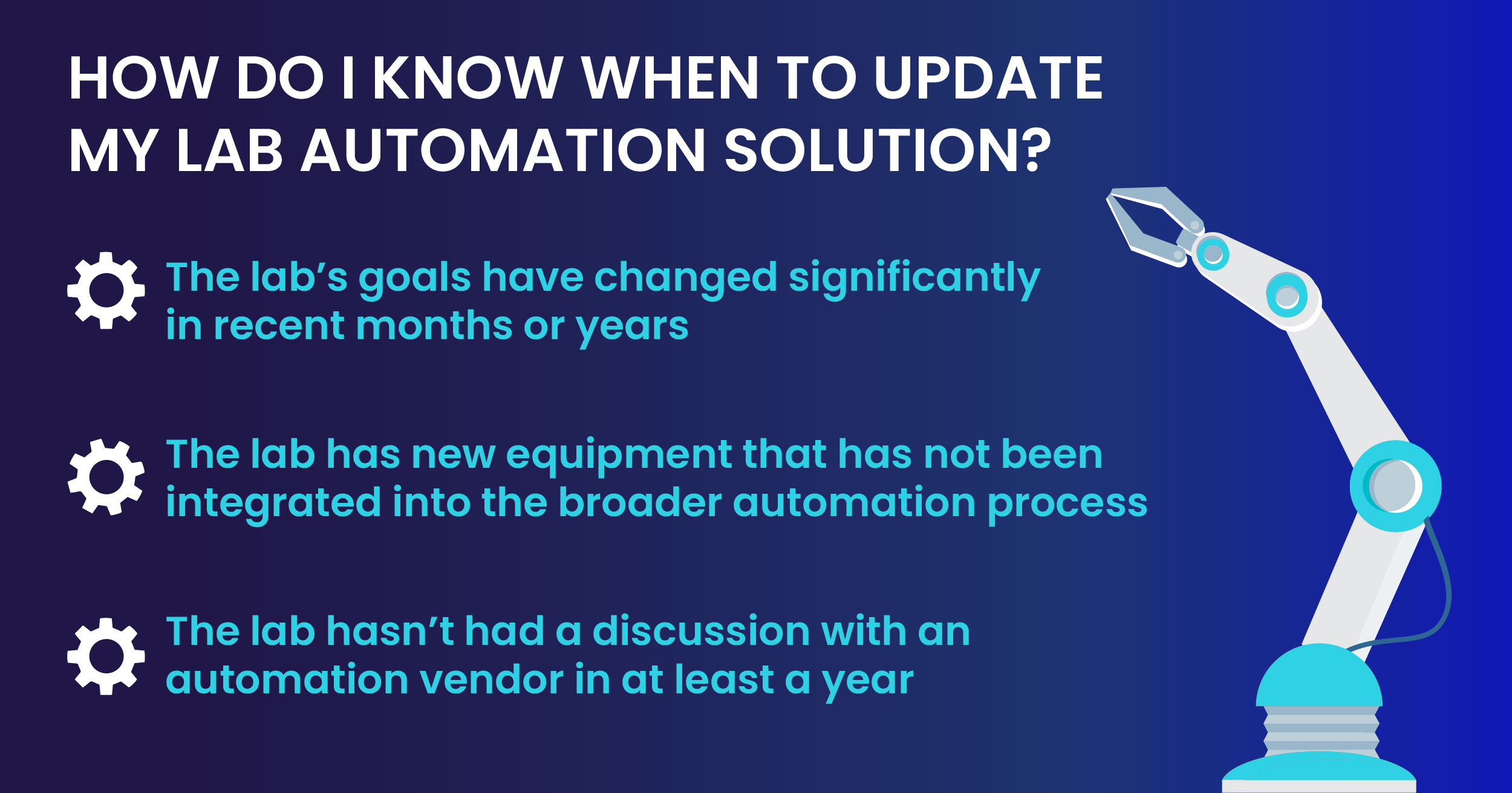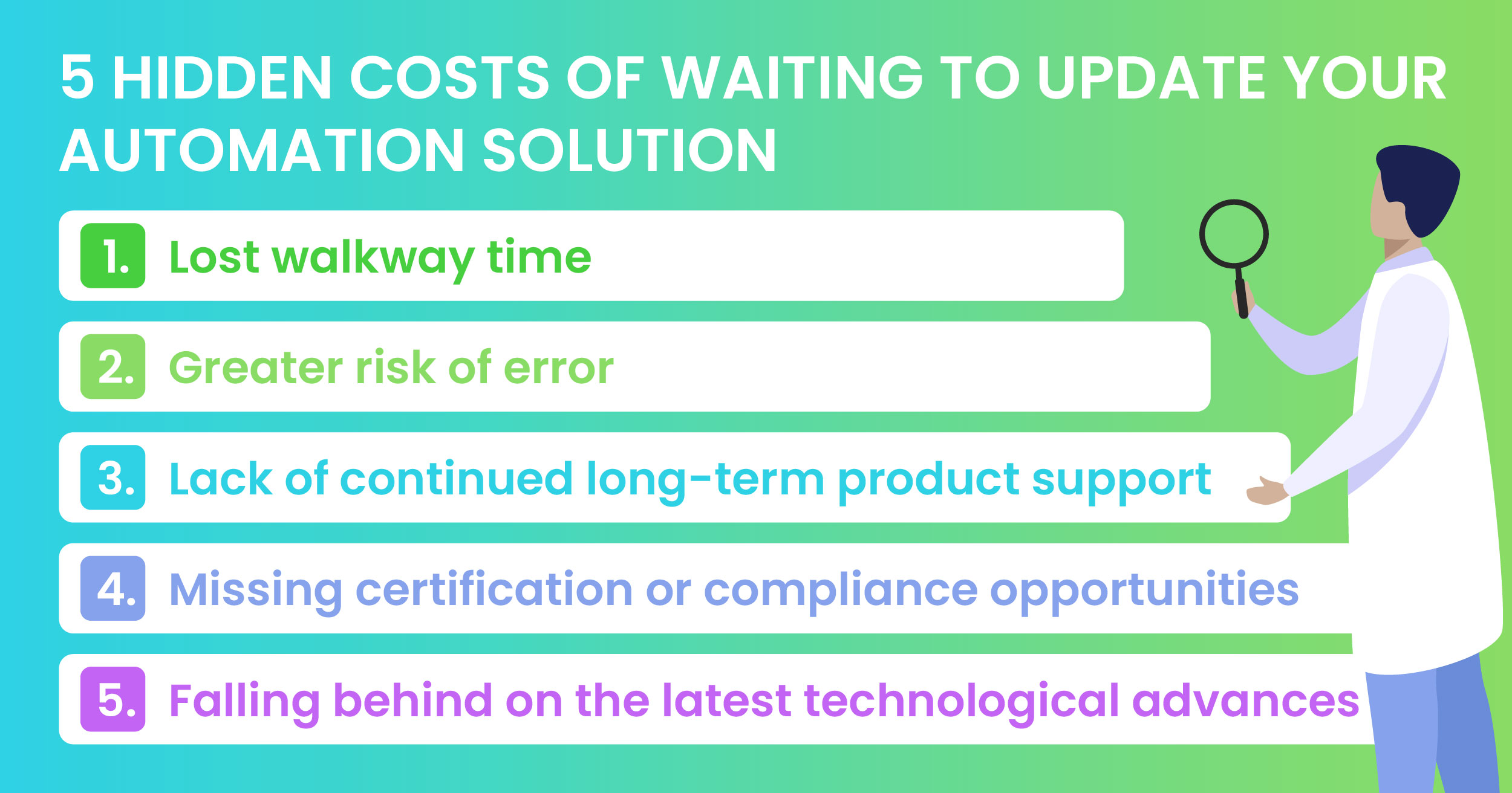Waiting to update your lab automation? 5 hidden costs you should know


The field of automation is advancing quickly. Instead of large, static systems, scientists now have the option of flexible, modular solutions that use less space and can be adapted to support new workflows as needed.
According to a 2018 Siemens Health survey of 99 US lab professionals, more than half of labs surveyed reported that they were planning to upgrade automation capabilities within the next two years.
As newer, more efficient versions of automation become available, scientists have to decide on the best time to update their systems. It can be tempting to keep using older versions of automated systems for as long as possible to keep costs down. But waiting too long to update a lab setup can actually cause problems that could end up being more expensive in the long run.
How do I know when to update my lab automation solution?
There’s no clear cut answer here. Technological advances in the lab automation space continue to move at a fast pace. New innovations allow for better quality results, improved throughput, faster turnaround times, and increased efficiency to allow for more scientist walkaway time.
There are some guideposts labs can follow to determine if the current automation solution is in need of an upgrade. 
- The lab’s goals have changed significantly in recent months or years. This might mean your current solution is not tailored to most effectively hit your goals any longer.
- The lab has new equipment that has not been integrated into the broader automation process. As the field evolves, new ways to incorporate every component into one central hub is becoming easier.
- The lab hasn’t had a discussion with an automation vendor in at least a year. A lot happens in 12 months, and vendors likely have new advances and solutions that could make the lab run smoother, faster, and safer.
Curious about the hidden costs of waiting to update automated solutions in the lab? Read on. 
#1. Lost walkway time
Many labs process hundreds or even thousands of samples every week, and automation is a great way to reduce the time needed for manual intervention, freeing scientists up to perform other tasks. But as legacy systems get older and slower, that free time can dwindle as systems require more maintenance or fail to keep up with higher demand. Scientists can quickly find themselves working longer hours or waiting days for results, increasing employee burnout. They could also find themselves spending more money to maintain versions of systems that are no longer supported by the manufacturer.
#2. Greater risk of error
Even the most skilled scientists don’t run experiments in exactly the same way every time. Variations in the ways people work can lead to process mistakes and errors in results. This is why automation offers so much value, giving scientists the confidence that tasks are performed the same way every time. But failing to update automation can introduce more mistakes in the lab as older systems are more likely to break down, fail mid-task, or have compatibility issues with newer devices.
According to a study published in Clinical Chemistry and Lab Medicine, pre-analytical errors account for up to 70% of all mistakes made in laboratory diagnostics, with most of them attributed to mishandling procedures during collection, handling, preparing, or storing specimens.
Older systems can also have a harder time capturing new forms of data or scaling up to handle more samples as the lab’s needs change. Scientists may have to spend more time monitoring their workflows and checking experiments to ensure that there haven’t been any mistakes.
#3. Lack of continued long-term product support
Like other kinds of hardware and software we encounter in our lives, over time, automation solution manufacturers may stop supporting devices and their accompanying software programs as the years go on. Labs who continue to use solutions past their support date run the risk of not getting the right assistance if or when errors arise. And when a software product is no longer supported, that often means bugs that come up are there to stay, resulting in programs that are no longer dependable. Other potential risks include data and security vulnerabilities, incompatibilities with other lab components, or even full system failure.
#4. Missing certification or compliance opportunities
Detailed records of lab activities, audit trails, and new security processes are important requirements for receiving certifications and compliance signoff from standards organizations. It's much easier for scientists to gather the information needed to submit successful applications if all of that information is gathered in one place.
Updating automation solutions can mean reaping new benefits that automation vendors may have developed in recent years, including robust new features that support scientists who need to operate in a 21 CFR Part 11 compliant manner. When systems are out of date, scientists could be losing important data needed for those submissions or may have to do the heavy lifting of proving data and security compliance themselves.
#5. Falling behind on the latest technological advances
Using dated technology often means that scientists aren't equipped with the best tools for their jobs. Science moves quickly. And teams that have to contend with glitchy, outdated systems will have a harder time keeping up in a competitive landscape.
The phases of implementing new laboratory automation systems were outlined in a 2017 AACC article, including some of the technological benefits reaped from updating automation solutions in the lab:
“Our previous automation system—implemented over 17 years—included pre-analytical instruments that centrifuge, aliquot, and sort specimens, as well as ion-selective electrode, general chemistry, and immunoassay instruments,” wrote author Edward Ki Yun Leung, PhD. “The new system replaced the analytical instruments and added a new post-analytical refrigerated automated specimen storage and retrieval system. The new instruments—by the same manufacturer as our old system—provided higher throughput, consolidated multiple instruments, and enabled us to add the post-analytical system without increasing the footprint of the overall system, which handles about 5 million tests annually.”
Even if your old automation solution works well, it is good to periodically evaluate newer systems that offer additional features and capabilities to see whether they are worth an upgrade. It's also valuable to build a relationship with the lab automation provider to stay up to date on their future product plans and roadmap. This way, labs can be proactive and come up with a plan to avoid many of the costs mentioned above.
Contact Biosero today to learn how we can help drive your research forward with precision and ease.


Want to automate smarter, not harder? Join the Biosero newsletter and stay in the loop with the latest lab automation strategies, success stories, and product updates.

